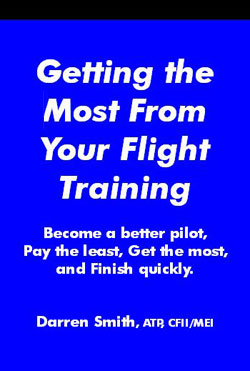
 | ||
| Home | Login | Schedule | Pilot Store | 7-Day IFR | IFR Adventure | Trip Reports | Blog | Fun | Reviews | Weather | Articles | Links | Helicopter | Download | Bio | ||
Site MapSubscribePrivate Pilot Learn to Fly Instrument Pilot 7 day IFR Rating IFR Adventure Commercial Pilot Multi-Engine Pilot Human Factors/CRM Recurrent Training Ground Schools Articles Privacy Policy About Me Keyword:  |
A lot of people think that you can apply for a pilot job at JetBlue, and they will train you to be a pilot. Unfortunately that's not true. Becoming a pilot for a major airline takes years or hard work and determination. Most of the people I know follow this route, because they don't feel like joining the military, and there is a lot more flexibility if you do it on your own. The following steps will lead you to success: 1. Get a Private Pilot Certificate - If you want to become an airline pilot, your going to need a pilot license. The first step is getting a private pilot license. During your training you will get 40-80 hours of flight time, and learn basic stuff about airplanes like takeoffs and landings, navigation, maneuvers, weather and basic instrument skills. In case your wondering about your vision, airline pilots need to have vision of correctable to 20/20. There are about 250,000 private pilots in America. 2. Get an instrument rating - An instrument rating is the next step after the private certificate. During your instrument training you will build at least 40 hours of instrument time, which means you are flying solely by reference to the instruments. You need to have this because airlines usually fly rain or shine, so you need to be able to navigate without ever looking outside. 3. Get a Commercial Pilot Certificate - After getting the instrument rating, you should continue to get your commercial certificate, which requires 250 hours of total flight time, along with additional training which will make you a more professional, safer, and experienced pilot. The commercial allows you to work for a commercial operator (an airline) and get paid for your services as a pilot. Many people get the multi-engine ratings at this time, you'll learn how to control the airplane with an inoperative engine including instrument approaches. There are less than 150,000 commercial pilots in America. 4. Building Experience - Now that you've got your commercial certificate with instrument and multi-engine ratings, you need to build flight experience. Since you probably have only about 300 hours of total time, airlines won't typically consider you. Airline minimums are at least 1,500 hours, along with some other experience. 5. Get a Flight Instructor Certificate - So how do you get from 300 hours to the 1500+ that you need for the airlines? The most common way is flight instructing. By becoming a flight instructor, you are able to build hours and get paid to teach others. 6. Get an ATP certificate - Major airlines won't usually consider hiring you unless you have the ATP certificate, which allows you to be a captain. Regional airlines may hire you without one, which is a good way to build experience. Some people consider this the "doctoral degree of flying." There are less than 150,000 ATP rated pilots in America. 7. Get a 4 year university degree - At least a four year degree is needed to get a job with an airline. The degree does not have to be in Aviation, you can major in about any field. In fact, business has long believed that diverse backgrounds in their employee groups produce higher performance. You can always apply for airline jobs without the 4 year degree, but you'll be competing with others who have them. When it comes to investing the time and resources to interview, hire, and train applicants, employers always look at the top of the pile. Without a degree, you'll be quickly put at the bottom of the pile. 8. Start Applying - Once you've got the time, degree,
and are
ready to see if you've got what it takes, apply to every airline you
can!
This way you can be picky if you get interviews. It is
recommended
that you begin applying as soon as you hit 1500 hours, this way you
will
have built a file with the company and you should have your ATP by the
time you are ready for an interview. Your Thoughts... |

|
| Home | Login | Schedule | Pilot Store | 7-Day IFR | IFR Adventure | Trip Reports | Blog | Fun | Reviews | Weather | Articles | Links | Helicopter | Download | Bio |
| All content is Copyright 2002-2010 by Darren Smith. All rights reserved. Subject to change without notice. This website is not a substitute for competent flight instruction. There are no representations or warranties of any kind made pertaining to this service/information and any warranty, express or implied, is excluded and disclaimed including but not limited to the implied warranties of merchantability and/or fitness for a particular purpose. Under no circumstances or theories of liability, including without limitation the negligence of any party, contract, warranty or strict liability in tort, shall the website creator/author or any of its affiliated or related organizations be liable for any direct, indirect, incidental, special, consequential or punitive damages as a result of the use of, or the inability to use, any information provided through this service even if advised of the possibility of such damages. For more information about this website, including the privacy policy, see about this website. |